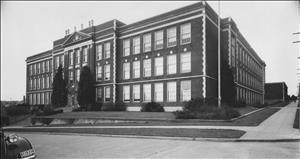This history of Alexander Hamilton Middle School is taken from the second edition of Building for Learning: Seattle Public School Histories, which includes histories of every school building used by the district since its formation around 1862. The original essay was written for the 2002 first edition by Nile Thompson and Carolyn J. Marr, and updated for the 2024 edition by HistoryLink contributor Tom G. Heuser.
Intermediate Education
The roots of Hamilton trace back to a resolution presented to the Seattle School Board on July 1, 1919, establishing a department for intermediate education. At the time, elementary and high schools suffered from overcrowding, and the intermediate school option (for grades 7-8) offered a solution. Intermediate-age enrollment in Seattle School District had increased by 78.5 percent between 1910 and 1923.
A site for a new intermediate school was purchased in 1920, but funds for construction had to await passage of three bond issues. The location near both Interlake School and Lincoln High School meant that these north-end schools could reduce their swelling enrollments. A group from the Wallingford neighborhood requested the school be named Wallingford Intermediate School. However, the board chose to name the school for Alexander Hamilton, statesman and first Secretary of the Treasury, in accordance with its policy of commemorating notable Americans.
Hamilton Intermediate School was the first school building in Seattle to be designed specifically for intermediate education. At the center of the structure was a lecture room, a lunchroom/stage, and kitchen. Surrounding the core were three floors of classrooms, corridors, and gymnasiums. The school was completed on January 28, 1927, and opened three days later. Beginning a new semester in their spacious new accommodations were 725 7th and 8th graders from Interlake, Day, Latona, Ross, and McDonald. Principal George Austin moved from Interlake to head the new school. The following year the next class of 7th graders arrived, and the building housed all three intermediate grades, expanding to include 9th grade. That year enrollment reached 1,274, which remained the peak until the early 1950s, when nearly 1,400 students attended the school.
1970 Remodel
Hamilton’s building was designed for a large capacity and has changed little in its exterior appearance. A 1970 remodeling project added a new learning resource center, updated auditorium, physical education facilities, new lockers, and student services offices.
In 1971, four junior high schools, including Hamilton, were converted to middle schools (grades 6-8) as part of an early desegregation plan. Classes in middle school followed the “continuous progress” method which emphasized individualized learning and team teaching. In 1972-1973, Hamilton was paired with Meany-Madrona Middle School for voluntary desegregation. When too few students volunteered, a mandatory program was implemented district wide.
During the 1970s, the school began a tradition of holding an annual multiethnic dinner where student artwork was displayed. A spring camp enabled two-thirds of the student body to participate in outdoor education. In the 1990s Hamilton focused on reading, math, and language arts. The 7th graders won the district-wide Math Olympiad in 1993 and an apprenticeship program for 8th graders. Students spent a class period at a local business to learn how businesses operate and what they look for in employees. Curriculum highlights included aerodynamics and rockets, the workings of the stock market, and U.S. government procedures.
Beginning in the fall of 2000, Hamilton became an international school, offering intensive foreign language instruction and a focus on global studies as a continuation of the John Stanford International School at Latona. Specific international programs included the International Arts Consortium, which provided international artists-in-residence, admission to the International Children’s Festival, and opportunities for students to work with the World Affairs Council and Jack Straw Productions on various projects.
Major changes came to the building following its designation as a City of Seattle landmark in 2006. With funding froma 2007 levy, the school district hired BLRB Architects to design a $73 million renovation and addition to Hamilton. The building closed after the 2007-2008 school year and Hamilton continued to operate at Lincoln as an interim location during construction. Construction was completed in time for reopening in the fall of 2010. The project included a new three-story atrium with a skylight located at the center of the school building’s original U-shape plan. This atrium functions as a commons, lunchroom, and theater. Other changes and additions include improved science classrooms, new classrooms for digital arts and fine arts, music, and band rooms, as well as a new gym, library, and outdoor garden.
From 2009 to 2011, Hamilton was named a Washington State School of Distinction, an award presented by a variety of state education organizations to the top 5 percent of schools that have demonstrated the most improvement in English Language Arts and Math over the previous five years.
History
Alexander Hamilton Intermediate School
Location: 1610 N 41st Street
Building: 41-room, 3-story brick
Architect: Floyd A. Naramore
Site: 1.9 acres
1925: Named on July 24
1927: Opened on January 31
1929: Changed to Alexander Hamilton Junior High School
1970: Remodeled
1971: Changed to Alexander Hamilton Middle School
2000: Changed to Hamilton International Middle School
2006: Designated a City of Seattle landmark
2007: School closed for construction; Students relocated to Lincoln as interim location
2010: Addition, renovation, and seismic retrofit (BLRB Architects)
Alexander Hamilton International Middle School in 2023
Enrollment: 1,039
Address: 1610 N 41st Street
Nickname: Hawks
Configuration: 6-8
Colors: Blue and yellow
Newspaper: The Messenger
Yearbook: Hamilton

